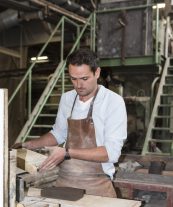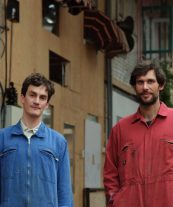COMMON GROUNDS: Tom van Soest x Studio ThusThat
 1
1
 2
2
— ‘Fifty years from now nobody uses virgin materials anymore’
In 2016 Tom van Soest wowed the DDA jury with his WasteBasedBrick, a sustainable building material alternative he actually managed to successfully bring to the market with Stonecycling. Recently, Tom returned to his roots by transforming his graduation project ‘Blended Materials’ into a design studio focusing on waste. He aims his spotlight on young designers Kevin Rouff and Paco Boeckelmann, who work together under the name Studio ThusThat, a studio with quite a reputation for creating thought-provoking projects, made out of industrial waste.
Changing impact
Paco: “Seeing a whole building that’s made from a material that was previously being discarded, has a different impact on the industry than seeing a chair or a lamp. And Tom has done just that: giving a real life example of what we can really do with waste.’’
Tom: “To have a large impact my recipes for recycled bricks needed to fit into the existing industry. Now, after ten years I know how difficult that is. I’ve recently gone back to working on a smaller scale, where you don’t have to worry about accessing very large waste streams, so you can focus on the story behind the waste and use that to create impact.”
Kevin: “We’ve been working with industrial waste that show signs of being usable as building materials. Recently we have wanted to shift focus and expand our reach and called Tom for advice. Some materials we use for pieces that are great conversation starters aren’t scalable. But now we also want to show materials that can be used at scale, for more impact.”
Tom: “When we started Stonecycling I only wanted to work with post-consumer waste, but now I’m switching to saying: no new raw materials. I’ve been staying at a factory that made glazed bricks in the south of Holland. They went bankrupt eighteen months ago and I’ve decided I want to try to restart it. They have thousands of small quantities of left-over glazes. You can argue if this is actually waste, but the owner was going to throw it out. I asked him to leave it here, and so now I can finally make something with brighter colours!”
A shared fascination
Paco: “We’re drawn to heavy industry and mining because there’s a lot of waste, and so inevitably there’s also plenty of research that’s been done. We also enjoy the chemistry involved in using these materials. We all kind of agree that we should stop producing single-use plastics for example, but we’re addicted. With metals, it’s more nuanced. People can be against mining, but at the same time pro wind turbines that contain the products of mining. We simply need these materials for a sustainable future.”
Tom: “Getting a circular economy going, involves people sharing information, accepting ideas from others and working together across different industries. Yet every company wants to be in their own bubble. Instead of doing it all separately, I’d like it all to be open source.”
Kevin: “Tom is dealing with the brick industry, for us it’s cement, but we’ve had similar interactions. What we realised is that a lot of building materials are made locally, so this protectiveness isn’t needed.”
Tom: “One person cannot change an entire industry and right now big factories don’t feel enough pain to change their practices. It will have to come from governments that say: “Enough, you need to incorporate at least fifty percent waste in your products.”
Paco: “Like in India, that has stated that one hundred percent of the red mud (the waste product from aluminum refining, red.) now has to be reused. There we see an entire country suddenly managing to deal with the problem.”
Kevin: “The regulatory system often lags behind ten to fifteen years, and there are many legislative barriers to using man-made materials. And we’re competing against materials that have had decades or even centuries to develop a narrative that everyone accepts. For instance, we accept that natural materials might have imperfections, but as soon as you start working with secondary materials, you have to conform to a lot of different standards.”
Role of the designer
Paco: “Working with waste is delicate, as some of it can be hazardous if you don’t know what you’re doing. As a designer you have to be knowledgeable enough to work with the experts, but also harness your expertise in creating a demand. We try to change the public perception towards a more optimistic future by showcasing that these materials can be functional, beautiful and desirable.’
Tom: ‘It’s not that difficult to make a brick from waste. So how it looks, is what’s going to matter. The designer can play a role in how your product can differ from its competitors. I also think it’s very important to show that working with waste can be appealing, because I firmly believe in the next fifty years everyone will be leaving out virgin materials.”
Kevin: “Also, it turns out that individual players, whether it’s suppliers, scientists or architects, aren’t very good at navigating towards one another. It seems like the designer can move between them more fluidly and play a role in connecting these fragmented spaces.”
Evelien Reich has been the chair of the Young Designer jury of Dutch Design Awards for the past three years. This year, she interviews the Young Designers DDA has selected from the archives and the talents those designers choose to spotlight. All twenty Young Designers from the past and the present will be showcasing their work in the 2024 DDA exhibition during Dutch Design Week in Eindhoven (19–27 October).
Discover the work of Tom van Soest and Studio ThusThat and all the other Young Designers of the Past & Present in the DDA24 exhibition at Microlab Hall on Strijp-S, during Dutch Design Week. From 19 to 27 October 2024 in Eindhoven.